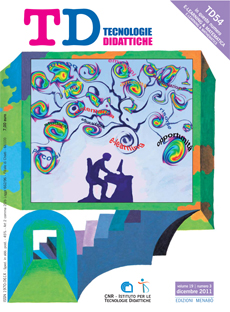Learning object e percorsi di apprendimento personalizzato in piattaforme di e-learning
Contenuto principale dell'articolo
Abstract
Dettagli dell'articolo
Gli autori che pubblicano su questa rivista accettano le seguenti condizioni:
- Gli autori mantengono i diritti sulla loro opera e cedono alla rivista il diritto di prima pubblicazione dell'opera, contemporaneamente licenziata sotto una Licenza Creative Commons CC BY 4.0 Attribution 4.0 International License.
- Gli autori possono aderire ad altri accordi di licenza non esclusiva per la distribuzione della versione dell'opera pubblicata (es. depositarla in un archivio istituzionale o pubblicarla in una monografia), a patto di indicare che la prima pubblicazione è avvenuta su questa rivista.
- Gli autori possono diffondere la loro opera online (es. in repository istituzionali o nel loro sito web) prima e durante il processo di submission, poiché può portare a scambi produttivi e aumentare le citazioni dell'opera pubblicata (Vedi The effect of Open Access).
Riferimenti bibliografici
Albano G., D’Auria B., Salerno S. (2003). A WebMathematica application for Mathematics learning. In Sloot et al. (eds.). Proceedings of the Third International Conference on Computational Science, ICCS 2003 (Melbourne, Australia e St. Petersburg, Russia, 2-4 giugno 2003), 2657 (1). Berlin, Heidelberg: Springer-Verlag, pp. 754-763.
Artigue M. (1992). Didactic engineering. In R. Douady, A. Mercier (eds.). Research in didactique of mathematics: selected papers (special issue). Recherches en Didactique des Mathématiques, 12, pp. 41-65.
Balacheff N., Sutherland R. (1999). Didactical complexity of computational environments for the learning of mathematics. International Journal of Computers for Mathematical Learning, 4 (1), pp. 1-26.
Chevallard Y. (1985). La transposition didactique. Du savoir savant au savoir enseigné. Grenoble: La Pensée Sauvage.
Duval R. (2006). The cognitive analysis of problems of comprehension in the learning of Mathematics. Educational Studies in Mathematics, 61 (1), pp. 103-131.
Ferrari P.L. (2004). Mathematical language and advanced mathematics learning. In M. Johnsen Høines, A. Berit Fuglestad (eds.). Proceedings of the 28th Conference of the International Group for the Psychology of Mathematics Education (Bergen, Norvegia, 14-18 luglio 2004) 2, pp. 383-390. Cape Town, South Africa: International Group for the PME, URL: http://www.emis.de/proceedings/PME28/RR/RR177_Ferrari.pdf (ultima consultazione settembre 2011).
Gaeta M., Orciuoli F., Ritrovato P. (2009). Advanced ontology management system for personalised e-learning. Knowledge-Based Systems– Special Issue on AI and Blended Learning, 22, pp. 292–301.
NCTM (2000). Principles and standards of school mathematics. URL: www.nctm.org/uploadedFiles/Math_Standards/12752_exec_pssm.pdf (ultima consultazione settembre 2011).
Rav Y. (1999). Why do we prove theorems?. Philosophia Mathematica, 7 (3), pp. 5-41.
Skemp R.(1976). Relational understanding and instrumental understanding. Mathematics Teaching, 77, pp. 20-26.
Way J. (2004). Multimedia learning objects in mathematics education. Proceedings of ICME 10, URL: http://www.icme-organisers.dk/tsg1 /Way.pdf (ultima consultazione settembre 2011).
Wiley D. A. (2000). Connecting learning objects to instructional design theory: a definition, a metaphor, and a taxonomy. In D. A. Wiley (ed.). The instructional use of learning objects. Bloomington, In, USA: Association for Educational Communications and Technology. URL: http://reusability.org/read/chapters/wiley.doc (ultima consultazione settembre 2011).

